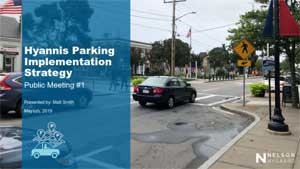

 Welcome
to the Town of Barnstable’s Parking Study webpage. The final Hyannis Parking
Study is now available. The Town is currently implementing short-term
solutions to improving the comprehensive parking system and will convene a
Parking Management Group to begin to review, evaluate, and implement the
study’s recommendations.
Welcome
to the Town of Barnstable’s Parking Study webpage. The final Hyannis Parking
Study is now available. The Town is currently implementing short-term
solutions to improving the comprehensive parking system and will convene a
Parking Management Group to begin to review, evaluate, and implement the
study’s recommendations.
What is it About?
The Town of Barnstable is undertaking a comprehensive study of parking supply, utilization, and management in Downtown Hyannis.
With its walkable downtown, vibrant restaurants, thriving local businesses and high-speed ferry service Hyannis is both a vibrant local economic hub and a major regional gateway to the Cape and Islands. This success has significant benefits, but also poses challenges. The Town benefits from huge numbers of seasonal visitors and economic development potential but must also balance economic growth with the year-round needs of local businesses and residents. A well-managed, flexible parking system can support these needs. This study effort aims to maintain the economic vibrancy of Downtown Hyannis while ensuring safety, improving mobility and addressing residents' concerns.
The Study
This study builds on the 2013 ULI Technical Assistance report and provides a comprehensive, data-driven assessment of existing supply and demand and immediate and mid-term implementation steps.
Using new parking counts and input from key stakeholders at the Town this report proposes a menu of smart parking strategies including better pricing, technology, design, and regulations. The study focuses on developing innovative, cost-effective, sustainable solutions that are responsive to the different needs of downtown user groups. Changes to the Town's parking management will only be successful with support from the Town, local business community, employees, residents, the regional transit operator, marine transportation companies, and other key stakeholders.
The Process
The Downtown Hyannis Parking Study is the result of a 12-month effort documenting the current parking supply and demand , regulations, estimating expected future parking demand, and recommending a series of strategies to achieve the study goals. The project team conducted a substantial public outreach effort that included two well-publicized public workshops, a dedicated project website, and on-line survey and multiple in-person. Working with the Planning & Development Department, the team then developed potential future land development models to test the capacity for the parking system to cater to future parking demand. This exercise, plus the findings of the field surveys, stakeholder meetings and experience of national best practices drove the development of parking strategies that will support economic development.